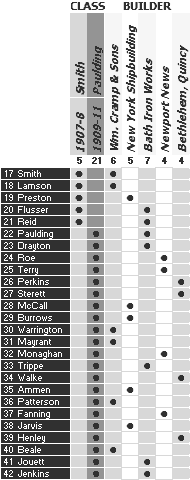

In fiscal year 1907, Congress authorized three torpedo boat destroyers that drew upon the board’s recommendations—the United States’ first construction in a program that continued without pause until the last flush deckers were delivered in 1922. Designed by the Navy Department, the new destroyers incorporated steam turbine power. The five initial 700-ton Smith-class ships were coal fired; 21 follow-on 742-ton Pauldings introduced oil firing. Shaft horsepower reached 10,000 for the first time; endurance was also increased.
The new torpedo boat destroyers carried over the high-forecastle “broken deck” hulls of the Bainbridge class, with a new cutaway stern and overall length increased by 43 feet to 293' 10". Initial armament was three single or twin torpedo tube mounts; the number of 3-inch rapid fire guns was increased to five.
Five builders participated in the program: Maine’s Bath Iron Works, the Fore River (Bethlehem Steel) yard at Quincy, Massachusetts, William Cramp & Sons and New York Shipbuilding on the Delaware River at Philadelphia and Camden, New Jersey respectively, and Newport News Shipbuilding on the James River in Virginia.
Keels for the 26 hulls were laid down between March 1908 and July 1911. As Flusser was the first Smith laid down, contemporary accounts refer to the Smiths as the Flusser class. (Similarly, the Pauldings were known as the Roe class.)
All the 700–742-tonners were placed in commission by the end of 1912. They were followed by a like number of 1,000-tonners, compared to which they became known as “flivvers,” i.e. lightweights.